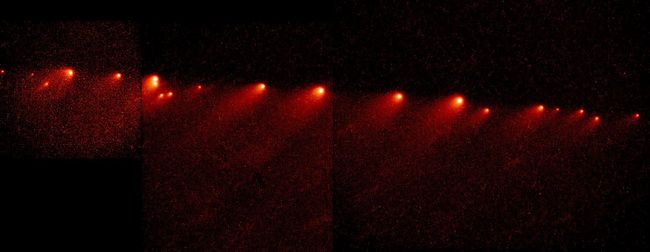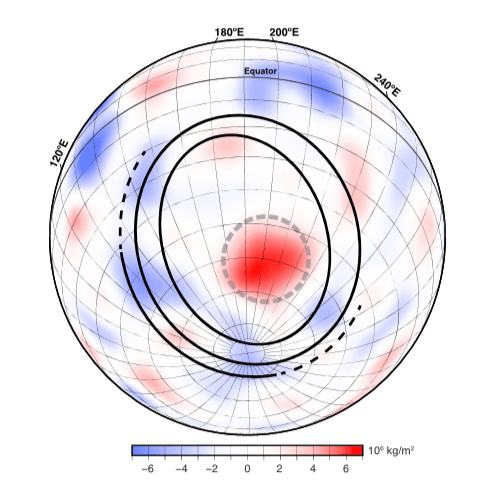Largest impact craters in the solar system
Apr 26, 2019 22:52:30 GMT -5
jamesp, opalpyrexia, and 2 more like this
Post by 1dave on Apr 26, 2019 22:52:30 GMT -5
The most active geological process in the universe is Impacts, and the Solar System has had many.

Two largest craters on Mercury
Caloris 1,550 km (963 mi)
Rembrandt 715 km (444 mi)
en.wikipedia.org/wiki/List_of_craters_in_the_Solar_System
Of course the very largest were probably on the gas giants and the sun itself, but we can only guess at those.
www.space.com/26562-jupiter-comet-crash-pictures-shoemaker-levy-9-1994.html

Each impact created plumes larger than the earth.


www.nasa.gov/mission_pages/MRO/news/mro-20080625.html
upload.wikimedia.org/wikipedia/commons/thumb/f/f3/MarsTopoMap-PIA02031_modest.jpg/1011px-MarsTopoMap-PIA02031_modest.jpg
en.wikipedia.org/wiki/List_of_largest_craters_in_the_Solar_System
The largest on the Moon:
1. Procellarum - 3,000 km (2,000 mi)
2. South Pole–Aitken basin - 2,500 km (1,600 mi)
3. Imbrium - 1,145 km (711 mi)
The largest known on Earth:
1. Vredefort 250–300 km (160–190 mi)
2. Sudbury Basin 250 km (160 mi)
3. Chicxulub crater 182 km (113 mi)
Obviously Earth had many much larger impacts that are now buried, destroyed, or simply not recognized.
There was the impact that created the moon!
What elements did they add to our planet?

Two largest craters on Mercury
Caloris 1,550 km (963 mi)
Rembrandt 715 km (444 mi)
en.wikipedia.org/wiki/List_of_craters_in_the_Solar_System
This is a list of named craters in the Solar System as named by IAU's Working Group for Planetary System Nomenclature. As of 2017, there is a total of 5,223 craters on 40 astronomical bodies, which includes minor planets (asteroids and dwarf planets), planets, and natural satellites.[1] All geological features of a body (including craters) are typically named after a specific theme.[2] For completeness, the list also refers to the craters on § Earth, which naming process is not overseen by IAU's WGPSN.
Of course the very largest were probably on the gas giants and the sun itself, but we can only guess at those.
www.space.com/26562-jupiter-comet-crash-pictures-shoemaker-levy-9-1994.html

Each impact created plumes larger than the earth.

The largest visible crater in the solar system is on Mars.
www.nasa.gov/mission_pages/MRO/news/mro-20080625.html
The mystery of the two-faced nature of Mars has perplexed scientists since the first comprehensive images of the surface were beamed home by NASA spacecraft in the 1970s. The main hypotheses have been an ancient impact or some internal process related to the planet's molten subsurface layers. The impact idea, proposed in 1984, fell into disfavor because the basin's shape didn't seem to fit the expected round shape for a crater. The newer data is convincing some experts who doubted the impact scenario.
"We haven't proved the giant-impact hypothesis, but I think we've shifted the tide," said Jeffrey Andrews-Hanna, a postdoctoral researcher at the Massachusetts Institute of Technology in Cambridge.
Andrews-Hanna and co-authors Maria Zuber of MIT and Bruce Banerdt of NASA's Jet Propulsion Laboratory in Pasadena, Calif., report the new findings in the journal Nature this week.
A giant northern basin that covers about 40 percent of Mars' surface, sometimes called the Borealis basin, is the remains of a colossal impact early in the solar system's formation, the new analysis suggests. At 5,300 miles across, it is about four times wider than the next-biggest impact basin known, the Hellas basin on southern Mars. An accompanying report calculates that the impacting object that produced the Borealis basin must have been about 1,200 miles across. That's larger than Pluto.
"We haven't proved the giant-impact hypothesis, but I think we've shifted the tide," said Jeffrey Andrews-Hanna, a postdoctoral researcher at the Massachusetts Institute of Technology in Cambridge.
Andrews-Hanna and co-authors Maria Zuber of MIT and Bruce Banerdt of NASA's Jet Propulsion Laboratory in Pasadena, Calif., report the new findings in the journal Nature this week.
A giant northern basin that covers about 40 percent of Mars' surface, sometimes called the Borealis basin, is the remains of a colossal impact early in the solar system's formation, the new analysis suggests. At 5,300 miles across, it is about four times wider than the next-biggest impact basin known, the Hellas basin on southern Mars. An accompanying report calculates that the impacting object that produced the Borealis basin must have been about 1,200 miles across. That's larger than Pluto.
upload.wikimedia.org/wikipedia/commons/thumb/f/f3/MarsTopoMap-PIA02031_modest.jpg/1011px-MarsTopoMap-PIA02031_modest.jpg
en.wikipedia.org/wiki/List_of_largest_craters_in_the_Solar_System
The largest on the Moon:
1. Procellarum - 3,000 km (2,000 mi)
2. South Pole–Aitken basin - 2,500 km (1,600 mi)
3. Imbrium - 1,145 km (711 mi)
The largest known on Earth:
1. Vredefort 250–300 km (160–190 mi)
2. Sudbury Basin 250 km (160 mi)
3. Chicxulub crater 182 km (113 mi)
Obviously Earth had many much larger impacts that are now buried, destroyed, or simply not recognized.
There was the impact that created the moon!
What elements did they add to our planet?











 ... to the New Guys from The ChatBox V.2 Crew
... to the New Guys from The ChatBox V.2 Crew